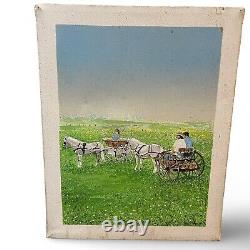
- Homepage
- Framing
- Item Height
- Signed
- Size
- Subject
- Type
- Bookends (41)
- Candle Holder (24)
- Candle Holders (18)
- Candlesticks (26)
- Chairs (17)
- Figurine (49)
- Figurines & Statues (14)
- Lamps (43)
- Metal & Ironwork (14)
- Painting (326)
- Plates (16)
- Print (88)
- Sconce (150)
- Sconce Bronze (15)
- Sconces (16)
- Sculpture (37)
- Statue (35)
- Table Lamp (77)
- Vase (113)
- Vases (51)
- ... (2982)
Pair Artist Signed Paul Shaub Acrylic On Canvas Horse Drawn Carriage Woods Field















Pair Artist Signed Paul Shaub Acrylic On Canvas Horse Drawn Carriage Woods Field. Both pieces signed by Artist Paul Shaub. The pieces are both unframed and measure 8" X 10".
Both pieces are signed by Artist Paul Shaub in the lower right corner. Born in Steelton, Pennsylvania in 1923, Paul Shaub, and his wife, Josephine Emmons Shaub, lived and ran a gallery in picturesque New Castle, Delaware until at least 2016, named Studio 51, located on 2nd street. It seems Shaub spent most of his most prolific years in the Philadelphia area. He was co-proprietor The Packet Press, which did not leave many traces we could find. He was for a time a member of the American Color Print Society, The Society of American Graphic Artists, as well as the Philadelphia Art Alliance. For the latter organization, which was then still an independent school (now part of the University of the Arts), he served as chairman of the print committee. It seems Paul Shaub made a living doing more than teach and create art. He also designed exhibits and graphics at the Hagley Museum; and he taught at and directed the section of Professional Studies at the Moore College of Art, also in Philadelphia. In the late 1950s Shaub seems to have discovered the art of making color woodcuts. The palettes of these maritime compositions are subdued: gray, beige, and olive-green dominate. It seems Shaub carved these dark silhouettes of boats, rowers and people in oblong formats mostly. In these prints, the grain of the wood plank is used to create texture throughout the composition.In the mid-1960s his work evolved towards abstraction, first keeping a foot in representation, with cubist tendencies, as can be found in nude etchings; later Shaub created fully abstract works, executed as serigraphs, gouaches and paintings, or woodcuts and assorted intaglio. Shaub's work, which deserves to be rediscovered, can be found in many American museums, including The Smithsonian American Art Museum, The National Gallery of Art, The Philadelphia Museum of Art. Shaub and his wife in 1958 also co-authored Squeaky the Mechanical Whale (signed Judy and Paul Shaub). Paul E Shaub (sometimes last name misspelled as Schaub).

